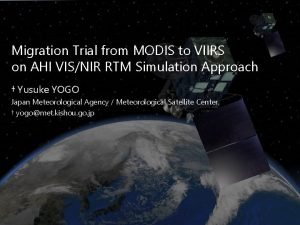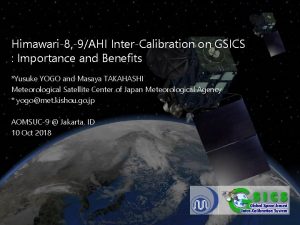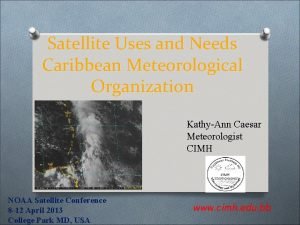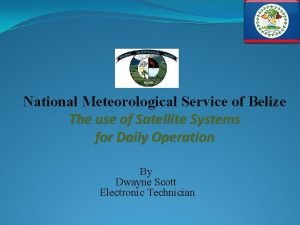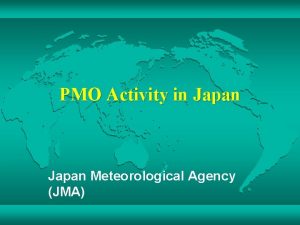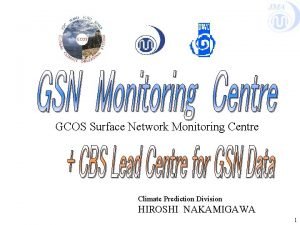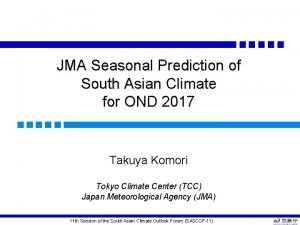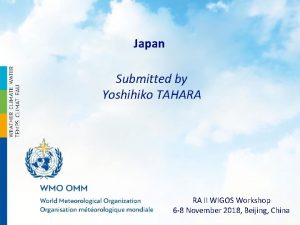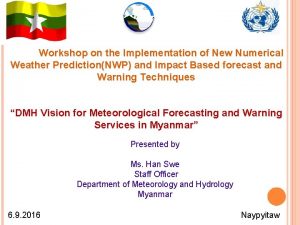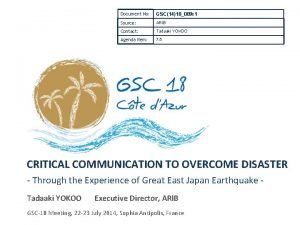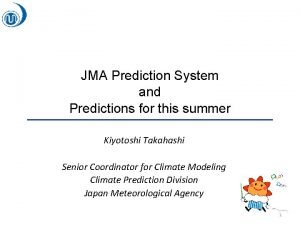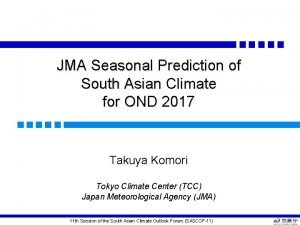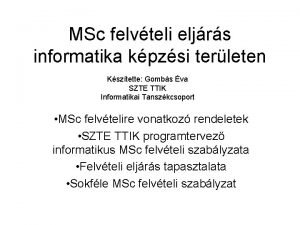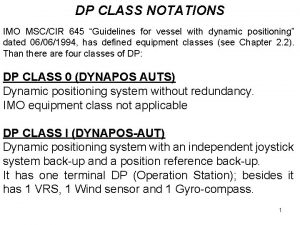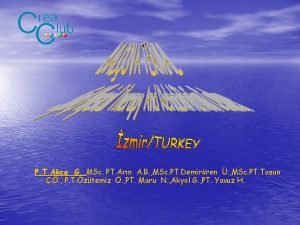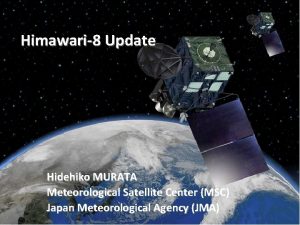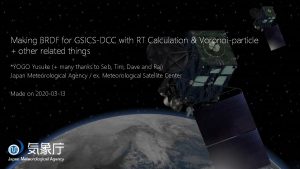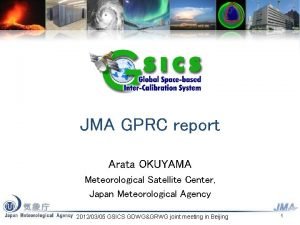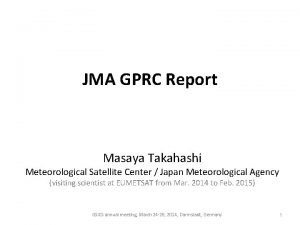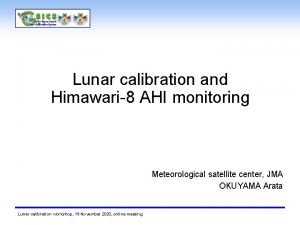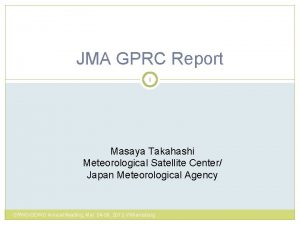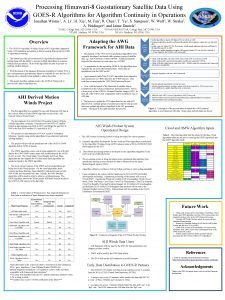Meteorological Satellite Center MSC of JMA Himawari8 9AHI















- Slides: 15

Meteorological Satellite Center (MSC) of JMA Himawari-8, -9/AHI Inter-Calibration on GSICS : Importance and Benefits *Yusuke YOGO and Masaya TAKAHASHI Meteorological Satellite Center of Japan Meteorological Agency * yogo@met. kishou. go. jp AOMSUC-9 @ Jakarta, ID 10 Oct 2018

Meteorological Satellite Center (MSC) of JMA Overview • Basics of Inter-Calibration – Why is inter-calibration needed? – International Cooperation in GSICS • Inter-Calibration Methods for Himawari-8, -9/AHI – VIS/NIR – IR • Some Practices for Utilizing Inter-Calibration – Case 1: Flood Mapping (NOAA's activity) – Case 2: RGB Composite Imagery • Summary 10 Oct 2018 AOMSUC-9 @ Jakarta, ID 2

Meteorological Satellite Center (MSC) of JMA Why is inter-calibration needed? • VIS-IR (0. 4 -15 μm) Radiometric calibration can be divided to 3 types 1. Pre-launch calibration decides relationship between radiance and sensors' electric response by using highly accurate instruments (integrating spheres, . . . ) �� However, sensor's characteristics could change after launch Credit: NASA/JPL 2. On-board calibration re-decides relationship between them by using on-board facilities (blackbodies, solar diffusers, . . . ) �� On-board calibration may not be 100% accurate and facilities could degrade after launch 3. Vicarious calibration validates and corrects above results by using alternative methods such as • observing stable surfaces (desert, ocean, moon, . . . ) • comparing with other sensors: inter-calibration 10 Oct 2018 AOMSUC-9 @ Jakarta, ID Credit: NASA/GSFC Credit: NASA/JPL 3

Meteorological Satellite Center (MSC) of JMA cited and revised from 2017 GSICS Annual Meeting 1 a presented by Tim Hewison International Cooperation in GSICS • Global Space-based Inter-Calibration System – Effort to produce consistent, well-calibrated data from the international satellite constellation – Initiative of CGMS and WMO • What are the basic strategies of GSICS? – Improve on-orbit calibration by developing an integrated inter-comparison system CMA CNES ESA EUMETSAT ISRO IMD JAXA JMA KMA NASA NIST NOAA USGS WMO – Best practices for calibration & characterisation • This will allow us to: – Improve consistency between instruments – Reduce bias in products – and more ROSCOSMOS ROSHYDROMET 10 Oct 2018 AOMSUC-9 @ Jakarta, ID 4

Meteorological Satellite Center (MSC) of JMA cited and revised from 2017 GSICS Annual Meeting 1 a presented by Tim Hewison GSICS: Who are the targeted users? You (AOMSUC participants) may be here! = GSICS potential users • Satellite users interested in accurate/consistent calibration – Stable product generation – Climate Data Record generation – Reanalysis – Assimilation in NWP models • Satellite operators sharing developments, best practices, and tools – Prelaunch instrument characterization – In-orbit commissioning and Cal/Val plans – Instrument monitoring, detection/analysis of anomalies – Improved calibration • Partner programmes: CEOS WGCV, GPM X-cal, GHRSST, GRUAN, etc. . . 10 Oct 2018 AOMSUC-9 @ Jakarta, ID 5

Meteorological Satellite Center (MSC) of JMA Overview • Basics of Inter-Calibration – Why is inter-calibration needed? – International Cooperation in GSICS • Inter-Calibration Methods for Himawari-8, -9/AHI – VIS/NIR – IR • Some Practices for Utilizing Inter-Calibration – Case 1: Flood Mapping (NOAA's activity) – Case 2: RGB Composite Imagery • Summary 10 Oct 2018 AOMSUC-9 @ Jakarta, ID 6

Meteorological Satellite Center (MSC) of JMA AHI VIS/NIR Inter-Calibration Methods • Several VIS/NIR inter-calibration methods are being discussed in GSICS • JMA's currently main method for VIS/NIR: using Radiative Transfer Simulation – calculates radiance above cloud-free ocean and liquid water cloud • inputs MODIS L 1 B to retrieve aerosol or cloud parameters • uses the radiative transfer model RSTAR (Nakajima and Tanaka, 1986) MODIS L 1 B JMA Re. Analysis REAP CAPCOM Retrieval Software Aerosol &Cloud Params RSTAR Radiative Transfer Model Ozone Simulated Value Calibration Result Observed Value – Result (with Aqua/MODIS): generally stable, some bands have biases (< 5 %) 03 -12 Feb 2018 H 8/AHI [%] H 9/AHI [%] B 01 B 02 B 03 B 04 B 05 B 06 -1. 1 -2. 4 +0. 6 +1. 8 +3. 8 -3. 9 +3. 0 -2. 0 -1. 7 +0. 2 -1. 3 -5. 0 Results are available on the MSC/JMA website https: //www. data. jma. go. jp/mscweb/data/monitoring/gsics/vis/monit_visvical. html 10 Oct 2018 AOMSUC-9 @ Jakarta, ID 7

Meteorological Satellite Center (MSC) of JMA AHI IR Inter-Calibration Methods • LEO hyperspectral IR sounders (Metop-[A, B]/IASI, Aqua/AIRS and S-NPP/Cr. IS) as references 1. makes collocation between AHI and a reference 2. generates "AHI-equivalent" radiance from reference's observation and AHI's SRF 3. compares between AHI and "AHI-equivalent" – Result (with Metop-A/IASI, standard scene): small biases and very stable (< 0. 3 K) 03 -12 Feb 2018 H 8/AHI [K] H 9/AHI [K] B 07 B 08 B 09 B 10 B 11 B 12 B 13 B 14 B 15 B 16 -0. 15 -0. 27 -0. 28 -0. 16 -0. 11 -0. 29 -0. 03 -0. 02 -0. 09 +0. 06 -0. 07 -0. 28 -0. 07 -0. 16 -0. 11 -0. 21 -0. 09 -0. 10 -0. 11 -0. 21 Results are available on the MSC/JMA website https: //www. data. jma. go. jp/mscweb/data/monitoring/gsics/ir/monit_geoleoir. html 10 Oct 2018 AOMSUC-9 @ Jakarta, ID 8

Meteorological Satellite Center (MSC) of JMA Overview • Basics of Inter-Calibration – Why is inter-calibration needed? – International Cooperation in GSICS • Inter-Calibration Methods for Himawari-8, -9/AHI – VIS/NIR – IR • Some Practices for Utilizing Inter-Calibration – Case 1: Flood Mapping (NOAA's activity) – Case 2: RGB Composite Imagery • Summary 10 Oct 2018 AOMSUC-9 @ Jakarta, ID 9

Meteorological Satellite Center (MSC) of JMA cited and revised from GSICS-EP-19_Doc_3. 1 presented by Mitch Goldberg Case 1: Flood Mapping (NOAA's activity) • When using Himawari-8/AHI, �� flood area has been underestimated – because Himawari-8/AHI 1. 6 μm (B 05) has positive bias vs. S-NPP/VIIRS – After applying the inter-calibration result to Himawari-8/AHI, ☺ underestimation was corrected Flood Mapping for April 2017 Australia Floods by Himawari-8/AHI with inter-calibration result od Flo lse Fa Fa lse Flo od by S-NPP/VIIRS ☺ Applying inter-calibration result, underestimation was corrected ☺ AHI can avoid clouds thanks to its high temporal resolution 10 Oct 2018 �� AHI underestimated the flood due to its bias on 1. 6 μm band AOMSUC-9 @ Jakarta, ID 10

Meteorological Satellite Center (MSC) of JMA Case 2: RGB Composite Imagery • Bias could cause color difference of RGB composite imagery – Colors of RGB images from multi satellites might be inconsistent * Bias is not the only factor in color difference: e. g. , SRF difference • Example: Himawari-8, -9/AHI True Color Reproduction – �� H 9/AHI looks bluish because H 9/AHI 0. 47 μm (B 01) is ~5% brighter than H 8/AHI – After applying the inter-calibration result, ☺ the difference cannot be found Himawari-8 (Northern H) and 9 (Southern H) True Color Reproduction 08 Sep 2017 03: 30 UTC Himawari-8 + inter-cal. result Himawari-9/AHI is a little bit bluish 10 Oct 2018 AOMSUC-9 @ Jakarta, ID Himawari-9 There's no clear difference! 11

Meteorological Satellite Center (MSC) of JMA Overview • Basics of Inter-Calibration – Why is inter-calibration needed? – International Cooperation in GSICS • Inter-Calibration Methods for Himawari-8, -9/AHI – VIS/NIR – IR • Some Practices for Utilizing Inter-Calibration – Case 1: Flood Mapping (NOAA's activity) – Case 2: RGB Composite Imagery • Summary 10 Oct 2018 AOMSUC-9 @ Jakarta, ID 12

Meteorological Satellite Center (MSC) of JMA Summary • From VIS to IR (0. 4 -15 μm), 3 types of radiometric calibration are used: pre-launch, on-board and vicarious (incl. inter-) calibrations. • Inter-calibration helps us to make more certain and internationally consistent satellite images, datasets and products. • Himawari-8, -9/AHI are inter-calibrated by some methods. – VIS/NIR: using radiative transfer model (and more), some bands have biases (< 5 %) – IR: comparing with hyperspectral IR sounders, very stable (< 0. 3 K) • Inter-calibration results can be useful for not only satellite operators but also scientific users. 10 Oct 2018 AOMSUC-9 @ Jakarta, ID 13

Meteorological Satellite Center (MSC) of JMA End of Presentation • Thank you for your attention! Terima kasih atas perhatian Anda! 10 Oct 2018 AOMSUC-9 @ Jakarta, ID 14

Meteorological Satellite Center (MSC) of JMA Him-08(140. 7 E) Credit: HP Roesli GOES-16(89. 5 W) Met-10(0) Met-08(41. 5 E) 20 March 2017, First Global Dust RGB Composite 10 Oct 2018 AOMSUC-9 @ Jakarta, ID 15
